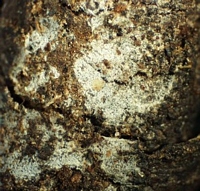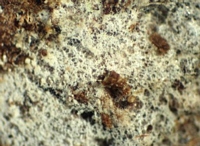|
 Botryobasidium subcoronatum Botryobasidium subcoronatum
SynonymsPellicularia subcoronata
Corticium subcoronatum
BiostatusPresent in region - Indigenous. Non endemic
Images (click to enlarge)
Caption: Botryobasidium subcoronatum, M 322
Owner: B.C. Paulus | 
Caption: Botryobasidium subcoronatum, M 322
Owner: B.C. Paulus |
Article: Cunningham, G.H. (1963). The Thelephoraceae of Australia and New Zealand. New Zealand Department of Scientific and Industrial Research, Bulletin 145: 359 p. Wellington:.
Description: Pellicularia subcoronata
(Hoehnel & Litschauer) Rogers, Farlowia 1: 104, 1943.
Corticium subcoronatum Hoehn. & Litsch., S.
B. Akad. Wiss. Wien 116: 822, 1907. Botryobasidium subcoronatum (H.
& L.) Donk, Meded. ned. mycol. Ver. 18-20: 117, 1931.
Hymenophore annual, adherent, arachnoid-mucedinioid, forming irregular
areas to 20 x 5 cm; hymenial surface cream or pallid ochre, tufted; margin
thinning out, arachnoid, concolorous, adherent. Context of a few repent hyphae
6-8 µm diameter, walls 0.2-0.5 µm thick, with clamp connections; fertile hyphae
erect, bearing lateral branches in botryose or coralloid clusters forming a
dense zone near the surface. Basidia developing at ends of lateral branches
singly or in groups of 2-4, subclavate, a few cylindrical, 8-12 x 5-7 µm,
bearing 6, sometimes 8 spores on slender sterigmata 2-4 µm long. Paraphyses
clavate, 6-8 x 4-5 µm. Spores narrowly fusiform or naviculate, with bluntly
acuminate ends, a few ovate, apiculate, 6-8 x 2.5-3.5 µm, walls smooth, hyaline,
0.1 µm thick.
Habitat: HABITAT: Effused on bark or decorticated
decaying wood.
Distribution: DISTRIBUTION: Europe, North America, Australia, Tasmania,
New Zealand.
Notes: Collections agree with specimens of
'Corticium subcoronatum' examined in Kew herbarium, differing in the
slightly smaller more subclavate basidia. The species may be separated from
others possessing clamp connections by the small, fusiform or naviculate spores.
Branchlets are arranged irregularly, some in coralloid groups, others in cymes.
Although basidia collapse early, spores long remain attached by the sterigmata.
Oil globules are abundant in the repent hyphae and main branches of the fertile
hyphae.
Article: Cunningham, G.H. (1963). The Thelephoraceae of Australia and New Zealand. New Zealand Department of Scientific and Industrial Research, Bulletin 145: 359 p. Wellington:.
Description: Hymenophore annual, adherent, arachnoid-mucedinioid, forming irregular areas to 20 x 5 cm; hymenial surface cream or pallid ochre, tufted; margin thinning out, arachnoid, concolorous, adherent. Context of a few repent hyphae 6-8 µm diameter, walls 0.2-0.5 µm thick, with clamp connections; fertile hyphae erect, bearing lateral branches in botryose or coralloid clusters forming a dense zone near the surface. Basidia developing at ends of lateral branches singly or in groups of 2-4, subclavate, a few cylindrical, 8-12 x 5-7 µm, bearing 6, sometimes 8 spores on slender sterigmata 2-4 µm long. Paraphyses clavate, 6-8 x 4-5 µm. Spores narrowly fusiform or naviculate, with bluntly acuminate ends, a few ovate, apiculate, 6-8 x 2.5-3.5 µm, walls smooth, hyaline, 0.1 µm thick.
Habitat: HABITAT: Effused on bark or decorticated decaying wood.
Distribution: DISTRIBUTION: Europe, North America, Australia, Tasmania, New Zealand.
Notes: Collections agree with specimens of
'Corticium subcoronatum' examined in Kew herbarium, differing in the
slightly smaller more subclavate basidia. The species may be separated from
others possessing clamp connections by the small, fusiform or naviculate spores.
Branchlets are arranged irregularly, some in coralloid groups, others in cymes.
Although basidia collapse early, spores long remain attached by the sterigmata.
Oil globules are abundant in the repent hyphae and main branches of the fertile
hyphae.
|